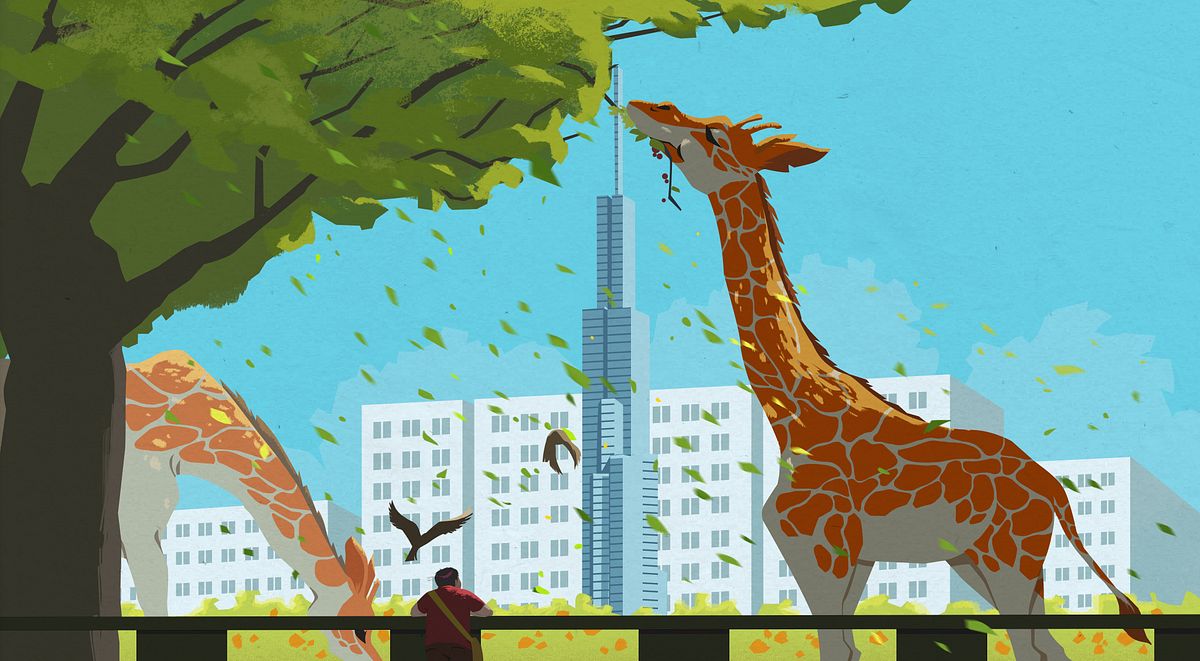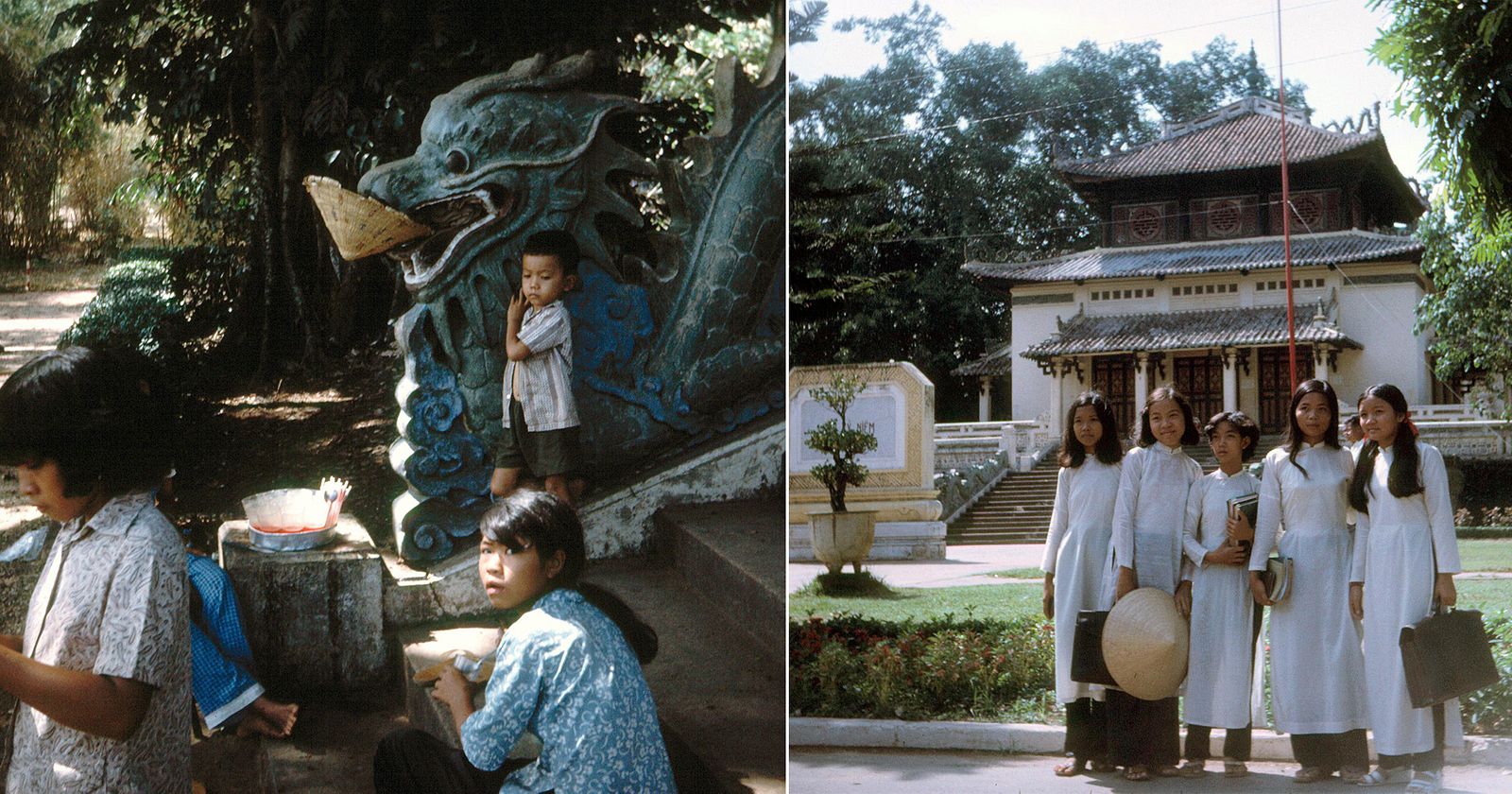We’ve all wanted something we can’t have. Something we can see but can’t touch. Something dangled in front of us but just out of reach like an especially succulent apple growing on a branch inches beyond a giraffe’s outstretched tongue. That was me during the Covid pandemic. My balcony overlooks the city’s zoo - every dawn I watch elephants emerge from their hut and eat the day’s first sweetgrass. I’m frequently awakened at three am by peacock cries - a sound somewhere between a meow, a scream and the ping of a pick-ax striking through stone and shattering a diamond. The zoo is my favorite place in Saigon and for a month and a half, I could gaze upon it but not visit.
To walk through a zoo is to be assaulted by the strangeness of the animal kingdom, hurled across continents, ecosystems and epochs of evolution and devastated by the sight of an elephant swaying its head in a way we would mistake for beatitude if we didn’t know it was a manifestation of immense stress and misery; devastated by the cruelty of cages; devastated by the countless examples of humankind’s destructive presence in the natural world, and thus devastated by the boundless pleasure one takes in visiting a zoo.

To walk through a zoo is to be assaulted by
the strangeness of the
animal kingdom
The Saigon zoo is so much more than a mere zoo (just consider the name: Thảo Cầm Viên Sài Gòn and not simply Sở Thú Sài Gòn). The home to 125 species of animals and 260 types of plants, it’s one of the oldest in the world. Commissioned in 1864 and opened in 1867, it was, like the majority of colonial projects, an effort to extract resources from then-Cochinchina. Rodolphe Alphonse Germain, an army veterinarian headed up work on animal husbandry while Jean-Baptiste Louis-Pierre researched plants: both with a goal of determining which variety could support the most lucrative industry with which to bleed Vietnam of its wealth. Rice, rubber, opium, coffee, alcohol, sex and spice: if this is what the colony was built upon, how wholesome could the zoo be?
Over the past 150 years, the Saigon Zoo has evolved into one that also promotes family entertainment, education and conservation, but money matters are never far from mind. I heard a rumor that two decades ago one of its tigers gave birth to a large litter of cubs. They were promptly drowned. The zoo couldn’t afford to feed them. The valuable clutch of kittens could no doubt have found homes at other zoos, but that would take work: phone calls, faxes, air transports and paperwork. Better a water bucket; the yelps hardly reaching the surface like so many air bubbles.

Is the zoo any different today? Consider the recently installed brick-a-brick assemblage of ramshackle amusement park attractions - bumper boats, bounce house, whirly-gigs, water slides, spinny-majigger, a pool filled with fish to nibble at one’s feet as a “massage;” cafes serving xúc xích, popcorn phở, Pepsi and potato chips. How many trees fell or flowers lost roots to make room for these chintzy cash grab distractions?
And yet, for all the emphasis on making money, some of the zoo’s business decisions baffle: guests can feed the kudu if they spend 10k for a bushel of bananas that the staff picks up from a local market. I’m sure they get a bulk discount, but for what I would spend 20k on the street for, I can get at half price at the zoo. Just as ripe and delicious too. I always buy some, eating the flesh myself and tossing the peels to the antelopes.

It doesn’t end there. From my house to the Saigoneer office, the zoo represents an ideal shortcut: it’s quiet, shaded, and if I had some extra time I could detour past the jaguar cage because, as Appollainaire may have said: “if you lack inspiration, go stare at a jaguar.” For such a routine to make fiscal sense though, I’d need an annual pass. The daily rate of 50K is of course shockingly low, but to pay that per each nine minute stroll would add up. So I contacted the zoo, explained my situation and offered VND2 million to enter as many times as I wanted for 12 months. That would equate 40 visits - a little less than once a week. Considering how strapped they are for cash, I’d hoped they would have jumped at such an offer, but I was curtly refused.
At this point, I must address the obvious: the animals at the zoo are not kept in the best conditions. Cramped, trash-littered enclosures, cold, urine-streaked concrete floors, a complete lack of simulation, occasional harassment by tourists. Certainly this is not ethical? Yet how much worse is it than any other zoo? A strong moral case could be made for the abolition of all zoos with room for counter-arguments sitting Tennyson’s claim that “nature is red in tooth and claw.” But if it were not for zoos, where would these animals, many of them endangered, go? As their wild populations continue to dwindle and their habitats disappear thanks to our collective consumptions, will a stable breeding population in captivity not be necessary to keep their entire species in existence? Alas, it seems that zoos represent the very least of humanity’s abuse of animals and the world they inhabit.
The same way that this article ignores the zoo’s Vietnam-HCMC History Museum and a Hung Kings Temple, it will ignore all issues regarding the morality of zoos (what are humans, afterall, if not able to compartmentalize?) and instead focus on the many reasons to love the Saigon Zoo. We must appreciate beauty in the ugly.


Saigon’s zoo is sometimes called the city’s lungs on account of its many oxygen-emitting trees. In a time when so many streets are being stripped of their vegetation, walking beneath the immense canopy one feels a certain calmness akin to when one was a child lying on their father’s chest, rising and falling with each inhale.
If you go to the zoo you must visit the orchid house and acknowledge the truth that Roethke articulated: “deep in their roots, all flowers hide the light” while remembering that flowerbed is an awfully poor term. Flowers do not sleep, they are forever shouting in a language we simply cannot understand: pollinate me, pollinate me, pollinate me. Yet, they remain silent when asked if they care whether we admire them or not.
Sculpting trees and bushes into clearly defined shapes ranging from boxes and circles to humans and logos dates back to Roman times and the ubiquity of these topiaries perhaps obscures their absurdity. Stranger still is the practice of creating versions of readily-visible creatures such as the myriad of plants carefully pruned to resemble animals the zoo contains. Why do I want to see an evergreen deer when I can see a real dear a few meters away? The shambly scrum of branches and leaves clutching exposed wires at the Saigon Zoo do a disservice to the elegance of trees and beasts alike. Plant is plant. Animal is animal. What do we gain by conflating the two?


Oh! The delights of a giraffe. The gangly-grace of a creature that can lick its own ears clean and keeps from fainting with high blood pressure pumped by a twenty-six pound heart. What pleasure it is to rummage through its lexicography. When first paraded through Paris’ streets, people gawked at what they thought was a bastard blend of camel and leopard so they gave it the scientific name Giraffa camelopardalis. Vietnam’s approach was slightly more sensible: hươu cao cổ or “long neck deer,” which although it's not actually a deer, makes sense. Meanwhile, upon initial encounter, the Japanese confused the animal with their dragon-scaled, stag-antlered god and thus named it Kirin. Two hundred years later salary men lift frosty mugs of Kirin, unconcerned if the beer’s name honors an African animal or ancient deity.

The hyena has been greatly slandered. The “devourer of the dead, trailer of calving cows, ham-stringer, potential biter-off of your face at night while you slept, sad yowler, camp-follower, stinking, foul, with jaws that crack the bones the lion leaves, belly dragging, loping away on the brown plain,” as Hemingway called them is maligned as a scavenger. Cast as a literal Disney villain that cowers from lions, waiting to snatch scraps of bones and gristle, nothing could be further from the truth. The efficient hunters bring down 2/3rds of their meals, but even if that weren’t true, what is so terrible about scavenging? Human society is built around not wanting to kill what we eat.

What do you see when you look at a hippopotamus? That gargantuan river pony whose head drifts on the surface like a grotesque, gray lily pad. A menacing beast? Boring attraction? I see potential! Saigon’s water hyacinth problem is greatly known and these mammals eat the weed with great alacrity! Why not release them into the city’s rivers and canals. Let them gorge on the invasive plant. And were they to multiply out of control on account of the abundance of good food, we could hunt them to serve at nhậu restaurants; the meat would be delicious seasoned with some fish sauce, dill, tamarind and basil.
Ông Địa, that fat and jolly deity that accompanies lion dances and keeps homes safe guards the earth his altar rests upon. I suggest on your next visit to the zoo you offer him a stick of burning incense and a banana (bought at previously discussed discount). Doing so may ensure that if developers ever come to ravage the zoo he will rise up to ruin their bulldozers’ engines, splinter their cranes and stupify their concrete mixers.

You don’t have to go to the zoo to look at the animals or ride the rides. Why not go to the zoo to drink beer and read books? Considering the lack of parks in the city and the existence of convenience store beers you’d be a fool not to! How fondly I remember doing just that when a rainstorm struck. Few moments are more romantic than sitting in a gazebo while the rain plays the roof like a percussion instrument, sipping a cold Jasmine IPA and reading Mary Oliver: “Whoever you are, no matter how lonely, the world offers itself to your imagination, calls to you like the wild geese, harsh and exciting—over and over announcing your place in the family of things.”


Speaking of romantic moments, the Saigon zoo is an ideal date location. Perhaps the city’s best. Shaded paths, secluded alcoves and a cornucopia of oddities to spur conversation, but the most amorous element is without question the Ferris wheel - a great circle of privacy that loops elegantly into the sky. It could bathe passengers in soft sunset, light dappling fertile Thủ Thiêm in the distance, barges slipping down the Saigon river like a dress easing off a shoulder. Yet! Rides end by 4pm; when the sun is still a sharp kidney stone lodged in the sky. Did this ever come up during the meetings regarding installing it?
And a few other questions:
1. If one were to commit suicide (which one probably should not do) via animal mauling, which cage would be best to jump into? Python? Tiger? Crocodile? Chimpanzee?
2. What animal is the most valuable in the zoo? I suppose to answer this question we would need to clarify if illegal animal poaching could be part of the equation and thus the rhino’s horn, tiger’s bone, sun bear’s bile considered? The ease at which a pangolin could be nabbed must explain why the Saigon Zoo contains none?
3. How many animals could escape the zoo if they only knew how? The shallow pits, flimsy wires and shoddy roof panels wouldn’t hold if tested. I’m looking at you rhinoceros: your species is in shambles, so scramble across that shallow moat and run-amok! Rabble-rouse down Nguyễn Huệ. This all used to be yours, afterall, didn’t it?

If given permission, it's not escaping is it? That holds true for the Silver Leaf Monkeys. The smallest ones are not only able, but allowed to slip through their bars and leap into the fruit-filled trees hanging over their cages. Not only that, I’ve seen them scamper into the giraffe enclosure meters away. Oh, I pity them on the morning they try to squeeze through the iron and no longer fit …. certainly freedom lost agonizes more than freedom never had.

Keep that in mind when considering the storks. Some are kept in cages and others are allowed to fly free - to sun on the ledge of the gaudy PetroLimex tower down the street and nest at night atop the very cage that imprisons others of their species. I don’t know what logic, if any, decides which birds are free and which imprisoned. Life is unfair. Simple, but true. We need no more proof.
One bird that couldn’t escape is certainly the cassowary. A creature kept with no net, no ceiling, nothing but 8 foot high bars. Oh the cruelty of the flightless. The 50kg bird’s scaly toe talons unquestionably resemble those of a Tyranosaur’s clawed feet. How it took so long for scientists to understand birds as the descendants of dinosaurs with such obvious proof existing in the form of a Cassowary is beyond me.
However, the Saigon Zoo is not oblivious to dinosaurs. In homage to the mid-1800s dinosaur sculptures placed in British parks, it features a collection of concrete dinosaurs tucked in a plant-filled nook at the front of the zoo. The anatomically off-base strike unscientific poses and become increasingly comical as their plaster bodies fall apart.
They are, however, not the strangest
statues in the zoo.


*It’s not a statue but the Robert Downy Jr. painting sure is strange. Certainly, when the Hollywood star was strung-out on heroin, sitting in prison in the 90s, the last thing he would have imagined was his image gracing the side of an amusement park ride in Vietnam.

If I were offered the chance to design a statue for the zoo, I would look to the two workers poking down starfruit from a tree on the grounds. “To eat with fish, for chả rươi” they said before handing me one to enjoy myself. The zoo employees are numerous, recognizable in their simple green uniforms with “Saigon Zoo” stretching across the back shoulders. They can be often observed sweeping brush, trimming limbs, shoveling dung or simply sitting down enjoying a cigarette. The pungent, poorly-paying job may not carry great prestige, and yet the staff always seems in good spirit. From dealing with bureaucracies to manual labor in the humid outdoors it’s a job few of us would want and yet thus their routinely cheerful moods is an inspiration. Let’s give them a statue.
The monkeys that are able to sneak in and out of their enclosures seem to have a nice life, but certainly the most blessed are the stray cats. Dozens of them reside in the zoo, and around dusk on a weekday when crowds are thin, cats certainly outnumber humans.

The cats prowl through the undergrowth; pounce on rats; play with one another on large patches of carefully tended grass and if they’re bold, will even slink towards a tourist for a nice head scratch. In addition to the vermin they catch, half-eaten garbage they pilfer from trash bins and feed they snatch from other animals, a local woman, Hong Tuyet Mai, has been feeding them for 15 years. These might be the luckiest animals in all of Saigon! Ample food, safe from traffic, free to roam in nature with their families. Not all people in the city have it so good.
My favorite cats in the zoo live near the monkey cages. A large family with kittens that grew considerably during the Covid closure, they are a multi-hued batch with a doting mother who is quick to sprint over when one gets too curious about my presence, scooping them away by the scruff of their necks.


On one occasion I witnessed the mother cat prancing inside the gibbon cage after effortlessly moving between the bars. Was she in there to steal some of their dinner? Did the enclosure represent safety from some imagined predatory animal lurking outside? Perhaps it was a shortcut to wherever she was going or maybe she simply enjoyed the shade cast on the cool cement floor.
Are the cats able to appreciate how good they have it? Is gratitude a strictly human emotion? Perhaps that is why I love the zoo so much: it invites an outpouring of gratitude. Gratitude for Saigon, gratitude for trees and nature, gratitude for the relentlessly bizarre and endearing world we inhabit, gratitude for the kindness and joy of strangers, gratitude for my own freedom, gratitude to seek joy. I contend there is no better place in the entire city to go and reflect on all the many blessings one has, however small, and embrace overwhelming gratitude.















